Asbestos Hazard in Serpentinite Rocks: Influence of Mineralogical and Structural Characteristics on Fiber Potential Release
Abstract
:1. Introduction
2. Materials and Methods
2.1. Geological Occurrence and Serpentinite Samples
2.2. Release Index Determination: Experimental Details
2.3. FTIR Method for Asbestos Quantification
3. Results
3.1. Petrographic Description of Massive, Foliated, and Cataclastic Serpentinites
3.2. Grinding and FTIR Tests Results
4. Discussion
5. Conclusions
Author Contributions
Funding
Data Availability Statement
Acknowledgments
Conflicts of Interest
References
- Ross, M.; Nolan, R.P. History of asbestos discovery and use and asbestos-related disease in context with the occurrence of asbestos within ophiolite complexes. In Ophiolite Concept and the Evolution of Geological Thought; Dilek, Y., Newcomb, S., Eds.; The Geological Society of America, Inc.: Boulder, CO, USA, 2003. [Google Scholar]
- Strohmeier, B.R.; Huntington, J.C.; Bunker, K.L.; Sanchez, M.S.; Allison, K.; Lee, R.J. What is asbestos and why is it important? Challenges of defining and characterizing asbestos. Int. Geol. Rev. 2010, 52, 801–872. [Google Scholar] [CrossRef]
- Militello, G.M.; Gaggero, L.; La Maestra, S. Asbestiform amphiboles and cleavage fragments analogues: Overview of critical dimensions, aspect ratios, exposure and health effects. Minerals 2021, 11, 525. [Google Scholar] [CrossRef]
- Bolan, S.; Kempton, L.; McCarthy, T.; Wijesekara, H.; Piyathilake, U.; Jasemizad, T.; Padhye, L.P.; Zhang, T.; Rinklebe, J.; Wang, H.; et al. Sustainable management of hazardous asbestos-containing materials: Containment, stabilization and inertization. Sci. Total Environ. 2023, 881, 163456. [Google Scholar] [CrossRef] [PubMed]
- Zaccagnini, E.; Marroni, M. Airborne dispersion of asbestos fibers from serpentinites: A simulation on ophiolites of pievescola area (Tuscany, Italy). Ofioliti 2013, 38, 75–87. [Google Scholar] [CrossRef]
- Marabini, A.; Fonda, A.; Plescia, P. Amianto Manuale Tecnico e Operativo, Consiglio Nazionale delle Ricerche; Italy Press: Rome, Italy, 2002. [Google Scholar]
- Marian, N.M.; Giorgetti, G.; Magrini, C.; Capitani, G.C.; Galimberti, L.; Cavallo, A.; Salvini, R.; Vanneschi, C.; Viti, C. From hazardous asbestos containing wastes (ACW) to new secondary raw material through a new sustainable inertization process: A multimethodological mineralogical study. J. Hazard Mater. 2021, 413, 125419. [Google Scholar] [CrossRef] [PubMed]
- Vergani, F.; Galimberti, L.; Marian, N.M.; Giorgetti, G.; Viti, C.; Capitani, G. Thermal decomposition of cement–asbestos at 1100 °C: How much “safe” is “safe”. J. Mater. Cycles Waste Manag. 2022, 24, 297–310. [Google Scholar] [CrossRef]
- Virta, R.L. Asbestos: Geology, Mineralogy, Mining, and Uses; US Department of the Interior, US Geological Survey: Washington, DC, USA, 2002. [Google Scholar]
- IARC. Some inorganic and organometallic compounds. In IARC Monographs on the Evaluation of Carcinogenic Risk of Chemicals to Man; World Health Organization: Geneva, Switzerland, 1973; Volume 2, pp. 1–181. [Google Scholar]
- Wagner, J.C.; Sleggs, C.A.; Marchend, P. Diffuse pleural mesothelioma and asbestos exposure in the North Western Cape Province. Br. J. Ind. Med. 1960, 17, 260–271. [Google Scholar] [CrossRef] [PubMed]
- Selikoff, I.J.; Churg, J.; Hammond, E.C. Relation between exposure to asbestos and mesothelioma. N. Engl. J. Med 1965, 272, 560–565. [Google Scholar] [CrossRef]
- Skinner, H.C.W.; Ross, M.; Frondel, C. Asbestos and Other Fibrous Materials: Mineralogy, Crystal Chemistry, and Health Effects; Oxford University Press: New York, NY, USA, 1988. [Google Scholar]
- Barrett, J.C.; Lamb, P.W.; Wiseman, R.W. Multiple mechanisms for the carcinogenic effects of asbestos and other mineral fibers. Environ. Health Perspect. 1989, 81, 81–89. [Google Scholar] [CrossRef]
- Guthrie, G.D.; Mossman, B.T. Health Effects of Mineral Dust; Mineralogical Society of America, Ed.; Reviews in Mineralogy; P.H. Ribbe Series; Walter de Gruyter: Berlin, Germany, 1993. [Google Scholar]
- Dela Cruz, C.S.; Tanoue, L.T.; Matthay, R.A. Lung cancer: Epidemiology, etiology, and prevention. Clin. Chest Med. 2011, 32, 605–644. [Google Scholar] [CrossRef]
- Gualtieri, A.F. Introduction. Mineral Fibres: Crystal Chemistry, Chemical–Physical Properties, Biological Interaction and Toxicity, Notes in Mineralogy; European Mineralogical Union and the Mineralogical Society of Great Britain & Ireland: Twickenham, UK, 2017; pp. 1–15. [Google Scholar]
- Decreto Legislativo (D.Lgs.) 17 March 1995. Available online: https://www.gazzettaufficiale.it/eli/id/1995/04/20/095G0149/sg (accessed on 27 June 2024).
- Decreto Ministeriale (DM) 14 May 1996. Available online: https://www.gazzettaufficiale.it/eli/id/1996/10/25/096A6000/sg (accessed on 27 June 2024).
- Lee, R.J.; Strohmeier, B.; Bunker, K.; Van Orden, D. Naturally occurring asbestos—A recurring public policy challenge. J. Hazard. Mater. 2008, 153, 1–21. [Google Scholar] [CrossRef] [PubMed]
- Giacomini, F.; Boerio, V.; Polattini, S.; Tiepolo, M.; Tribuzio, R.; Zanetti, A. Evaluating asbestos fibre concentration in metaophiolites: A case study from the Voltri Massif and SestriVoltaggio Zone (Liguria, NW Italy). Environ. Earth Sci. 2010, 61, 1621–1639. [Google Scholar] [CrossRef]
- Gaggero, L.; Crispini, L.; Isola, E.; Marescotti, P. Asbestos in natural and anthropic ophiolitic environments: A case study of geohazards related to the northern Apennine ophiolites (Eastern Liguria, Italy). Ofioliti 2013, 38, 29–40. [Google Scholar] [CrossRef]
- Belardi, G.; Vignaroli, G.; Trapasso, F.; Pacella, A.; Passeri, D. Detecting asbestos fibres and cleavage fragments produced after mechanical tests on ophiolite rocks: Clues for the asbestos hazard evaluation. J. Mediterr. Earth Sci. 2018, 10, 63–78. [Google Scholar] [CrossRef]
- Cossio, R.; Albonico, C.; Zanella, A.; Fraterrigo-Garofalo, S.; Avatenoe, C.; Compagnoni, R.; Turci, F. Innovative unattended SEM-EDS analysis for asbestos fiber quantification. Talanta 2018, 190, 158–166. [Google Scholar] [CrossRef]
- Viti, C.; Mellini, M. Mesh textures and bastites in the Elba retrograde serpentinites. Eur. J. Mineral. 1998, 10, 1341–1359. [Google Scholar] [CrossRef]
- Mevel, C. Serpentinization of abyssal peridotites at mid-ocean ridgesSerpentinisation des péridotites abysales aux dorsales océaniques. Comptes Rendus Geosci. 2003, 335, 825–852. [Google Scholar] [CrossRef]
- Vignaroli, G.; Rossetti, F.; Belardi, G.; Billi, A. Linking rock fabric to fibrous mineralisation: A basic tool for the asbestos hazard. Nat. Hazards Earth Syst. Sci. 2011, 11, 1267–1280. [Google Scholar] [CrossRef]
- Viti, C.; Mellini, M. Contrasting chemical compositions in associated lizardite and chrysotile in veins from Elba, Italy. Eur. J. Mineral. 1997, 9, 585–596. [Google Scholar] [CrossRef]
- Lahondère, D.; Cagnard, F.; Wille, G.; Duron, J. Naturally occurring asbestos in an alpine ophiolitic complex (northern Corsica, France). Environ. Earth Sci. 2019, 78, 540. [Google Scholar] [CrossRef]
- Rivero Crespo, M.A.; Pereira Gómez, D.; Villa García, M.V.; Gallardo Amores, J.M.; Sánchez Escribano, V. Characterization of Serpentines from Different Regions by Transmission Electron Microscopy, X-ray Diffraction, BET Specific Surface Area and Vibrational and Electronic Spectroscopy. Fibers 2019, 7, 47. [Google Scholar] [CrossRef]
- Punturo, R.; Ricchiuti, C.; Bloise, A. Assessment of Serpentine Group Minerals in Soils: A Case Study from the Village of San Severino Lucano (Basilicata, Southern Italy). Fibers 2019, 7, 18. [Google Scholar] [CrossRef]
- Lewis, I.R.; Chaffin, N.C.; Gunter, M.E.; Griffiths, P.R. Vibrational spectroscopic studies of asbestos and comparison of suitability for remote analysis. Spectrochim. Acta Part A 1996, 52, 315–328. [Google Scholar] [CrossRef]
- Gualtieri, A.F.; Tartaglia, A. Thermal decomposition of asbestos and recycling in traditional ceramics. J. Eur. Ceram. Soc. 2000, 20, 1409–1418. [Google Scholar] [CrossRef]
- Groppo, C.; Rinaudo, C.; Cairo, S.; Gastaldi, D.; Compagnoni, R. Micro-Raman spectroscopy for a quick and reliable identification of serpentine minerals from ultramafics. Eur. J. Mineral. 2006, 18, 319. [Google Scholar] [CrossRef]
- Petriglieri, J.R.; Salvioli-Mariani, E.; Mantovani, L.; Tribaudino, M.; Lottici, P.P.; Laporte-Magoni, C.; Bersani, D. Micro-Raman mapping of the polymorphs of serpentine. J. Raman Spectrosc. 2015, 46, 953. [Google Scholar] [CrossRef]
- Tarling, M.S.; Rooney, J.S.; Viti, C.; Smith, S.A.F.; Gordon, K.C. Distinguishing the Raman spectrum of polygonal serpentine. J. Raman Spectrosc. 2018, 49, 1978–1984. [Google Scholar] [CrossRef]
- Petriglieri, J.R.; Laporte-Magoni, C.; Salvioli-Mariani, E.; Ferrando, S.; Tomatis, M.; Fubini, B.; Turci, F. Morphological and chemical properties of fibrous antigorite from lateritic deposit of New Caledonia in view of hazard assessment. Sci. Total Environ. 2021, 777, 146185. [Google Scholar] [CrossRef]
- Petriglieri, J.R.; Barale, L.; Viti, C.; Ballirano, P.; Belluso, E.; Bruno, M.R.; Campopiano, A.; Cannizzaro, A.; Fantauzzi, M.; Gianchiglia, F.; et al. From field analysis to nanostructural investigation: A multidisciplinary approach to describe natural occurrence of asbestos in view of hazard assessment. J. Hazard. Mater. 2023, 457, 131754. [Google Scholar] [CrossRef]
- Viti, C.; Giacobbe, C.; Gualtieri, A.F. Quantitative determination of chrysotile in massive serpentinites using DTA: Implications for asbestos determinations. Am. Mineral. 2011, 96, 1003–1011. [Google Scholar] [CrossRef]
- Gualtieri, A.F.; Pollastri, S.; Bursi Gandolfi, N.; Ronchetti, F.; Albonico, C.; Cavallo, A.; Zanetti, G.; Marini, P.; Sala, O. Determination of the concentration of asbestos minerals in highly contaminated mine tailings: An example from abandoned mine waste of Crètaz and Èmarese (Valle d’Aosta, Italy). Am. Mineral. 2014, 99, 1233–1247. [Google Scholar] [CrossRef]
- Bloise, A.; Catalano, M.; Critelli, T.; Apollaro, C.; Miriello, D. Naturally occurring asbestos: Potential for human exposure, San Severino Lucano (Basilicata, Southern Italy). Environ. Earth Sci. 2017, 76, 648. [Google Scholar] [CrossRef]
- Decreto Legislativo (D.Lgs.) 152/2006. Available online: https://www.gazzettaufficiale.it/dettaglio/codici/materiaAmbientale (accessed on 27 June 2024).
- Labagnara, D.; Patrucco, M.; Rossetti, P. Predictive assessment of the asbestos content in the Western Italian Alps: An essential tool for an effective approach to risk analysis and management in tunneling operations and muck reuse. Environ. Earth Sci. 2013, 70, 857–868. [Google Scholar] [CrossRef]
- Lunardi, P.; Cassani, G.; Bellocchio, A.; Pennino, F. Naturally occurring asbestos in the Rocks belonging to Sestri–Voltaggio Zone (Liguria, Northern Italy). Excavation Railway tunnels management–Terzo Valico dei Giovi. In Proceedings of the World Tunnel Congress 2017–Surface challenges–Underground Solutions, Bergen, Norway, 9–15 June 2017. [Google Scholar]
- Boccaletti, M.; Guazzone, G. Il microcontinente sardo-corso come un arco residuo di un sistema arco-fossa miocenico. In Paleogeografia del Terziario Sardo Nell’ambito del Mediterraneo Occidentale; Maxia, C., Cerchi, A., Eds.; Rendiconti del Seminario delle Facoltà di Scienze dell’Università di Cagliari; Graficoop: Bologna, Italy, 1974; Volume 43, pp. 57–68. [Google Scholar]
- Principi, G.; Treves, B. Il sistema corso-appenninico come prisma d’accrezione. Riflessi sul problema generale del limite Alpi-Appennini. Mem. Della Soc. Geol. Ital. 1984, 28, 549–576. [Google Scholar]
- Ricci Lucchi, F. The Oligocene to recent foreland basins of the Northern Apennines. In Foreland Basins; Allen, P.A., Homewood, P., Eds.; Blackwell Scientific: Oxford, UK, 1986; Volume 8, pp. 105–139. [Google Scholar]
- Marzini, L.; D’Addario, E.; Papasidero, M.P.; Chianucci, F.; Disperati, L. Influence of Root Reinforcement on Shallow Landslide Distribution: A Case Study in Garfagnana (Northern Tuscany, Italy). Geosciences 2023, 13, 326. [Google Scholar] [CrossRef]
- Plesi, G.; Galli, M.; Daniele, G. The Monti Rognosi Ophiolitic Unit (cfr. Calvana Unit Auct.) paleogeographic position in the External Ligurian Domain, relationships with the tectonic units derived from the Adriatic margin. Boll. Della Soc. Geol. Ital. 2002, 1, 273–284. [Google Scholar]
- de Capoa, P.; D’Errico, M.; Di Staso, A. The succession of the Val Marecchia Nappe (Northern Apennines, Italy) in the light of new field and biostratigraphic data. Swiss J. Geosci. 2015, 108, 35–54. [Google Scholar] [CrossRef]
- Vespasiano, G.; Muto, F.; Apollaro, C. Geochemical, Geological and Groundwater Quality Characterization of a Complex Geological Framework: The Case Study of the Coreca Area (Calabria, South Italy). Geosciences 2021, 11, 121. [Google Scholar] [CrossRef]
- Zakrzewska, A.M.; Capone, P.P.; Iannò, A.; Tarzia, V.; Campopiano, A.; Villella, E.; Giardino, R. Calabrian ophiolites: Dispersion of airborne asbestos fibers during mining and milling operations. Period. Mineral. 2008, 77, 27–34. [Google Scholar] [CrossRef]
- Bloise, A.; Critelli, T.; Catalano, M.; Apollaro, C.; Miriello, D.; Croce, A.; Barrese, E.; Liberi, F.; Piluso, E.; Rinaudo, C.; et al. Asbestos and other fibrous minerals contained in the serpentinites of the Gimigliano-Mount Reventino Unit (Calabria, S-Italy). Environ. Earth Sci. 2014, 71, 3773–3786. [Google Scholar] [CrossRef]
- Bloise, A.; Belluso, E.; Critelli, T.; Catalano, M.; Apollaro, C.; Miriello, D.; Barrese, E. Amphibole asbestos and other fibrous minerals in the meta-basalt of the Gimigliano-Mount Reventino Unit (Calabria, south-Italy). Rend. Online Della Soc. Geol. Ital. 2012, 21, 847–848. [Google Scholar]
- Regione Toscana–DB Geologico. Available online: http://www502.regione.toscana.it/geoscopio/geologia.html (accessed on 27 June 2024).
- Tarling, M.S.; Smith, S.A.F.; Scott, J.M.; Rooney, J.S.; Viti, C.; Gordon, K.C. The internal structure and composition of a plate-boundary-scale serpentinite shear zone: The Livingstone Fault, New Zealand. Solid Earth 2019, 10, 1025–1047. [Google Scholar] [CrossRef]
- Bellopede, R.; Clerici, C.; Marini, P.; Zanetti, G. Rocks with Asbestos: Risk Evaluation by Means of an Abrasion Test. Am. J. Environ. Sci. 2009, 5, 501–507. [Google Scholar]
- Olori, A.; Di Pietro, P.; Campoiano, A. Preparation of ultrapure Kbr method for FTIR quantitative analysis. Int. J. Sci. Acad. Res. 2021, 2, 1015–1020. [Google Scholar]
- Marzini, L.; Ciofini, D.; Agresti, J.; Ciaccheri, L.; D’Addario, E.; Disperati, L.; Siano, S.; Osticioli, I. Exploring the Potential of Portable Spectroscopic Techniques for the Biochemical Characterization of Roots in Shallow Landslides. Forests 2023, 14, 825. [Google Scholar] [CrossRef]
- Accardo, G.; Cioffi, R.; Colangelo, F.; D’Angelo, R.; De Stefano, L.; Paglietti, F. Diffuse Reflectance Infrared Fourier Transform Spectroscopy for the Determination of Asbestos Species in Bulk Building Materials. Materials 2014, 7, 457–470. [Google Scholar] [CrossRef] [PubMed]
- Wu, S.; He, M.; Yang, M.; Zhang, B.; Wang, F.; Li, Q. Near-Infrared Spectroscopy Study of Serpentine Minerals and Assignment of the OH Group. Crystals 2021, 11, 1130. [Google Scholar] [CrossRef]
- Andreani, M.; Baronnet, A.; Boullier, A.M.; Gratier, J.P. A microstructural study of a “crack-seal” type serpentine vein using SEM and TEM techniques. Eur. J. Mineral. 2004, 16, 585–595. [Google Scholar] [CrossRef]
- Salvini, R.; Riccucci, S.; Gullì, D.; Giovannini, R.; Vanneschi, C.; Francioni, M. Geological application of UAV photogrammetry and terrestrial laser scanning in marble quarrying (Apuan Alps, Italy). In Engineering Geology for Society and Territory; Springer: Cham, Switzerland, 2015; Volume 5, pp. 979–983. [Google Scholar]
- Dershowitz, W.S.; Herda, H. Interpretation of fracture spacing and intensity. In Proceedings of the 33rd US Symposium on Rock Mechanics (USRMS), Santa Fe, NM, USA, 3–5 June 1992; Balkema, A.A., Ed.; [Google Scholar]

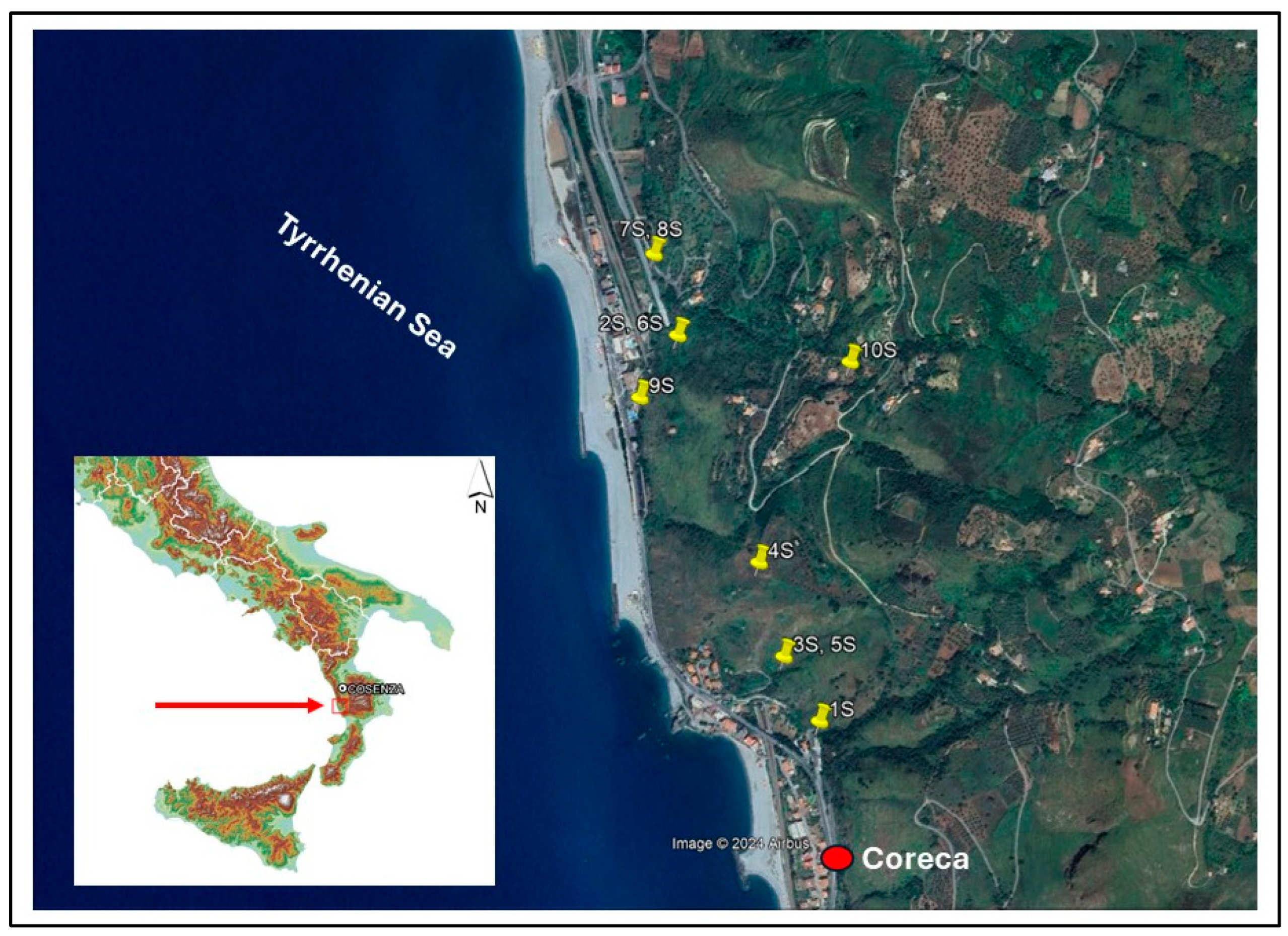

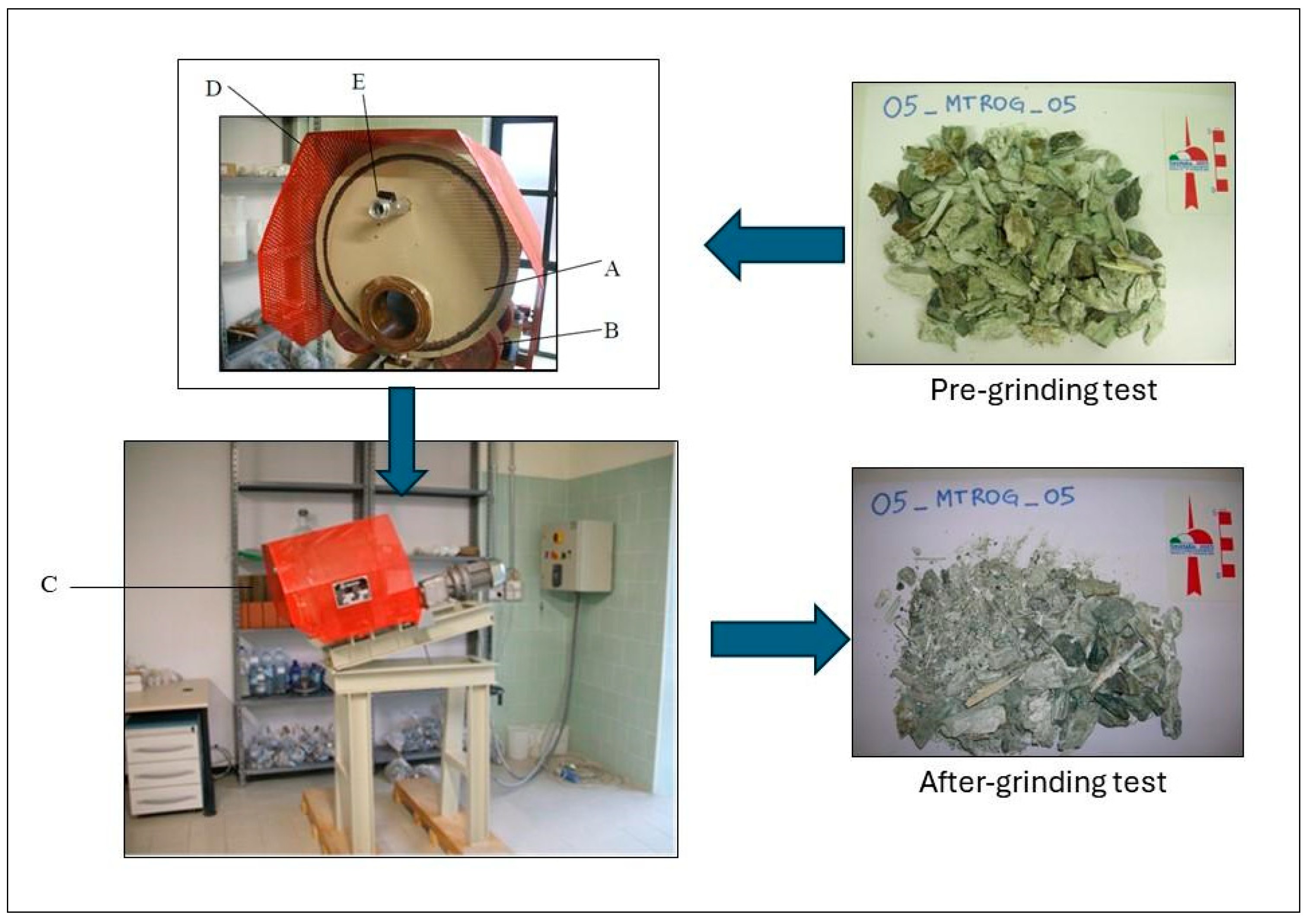


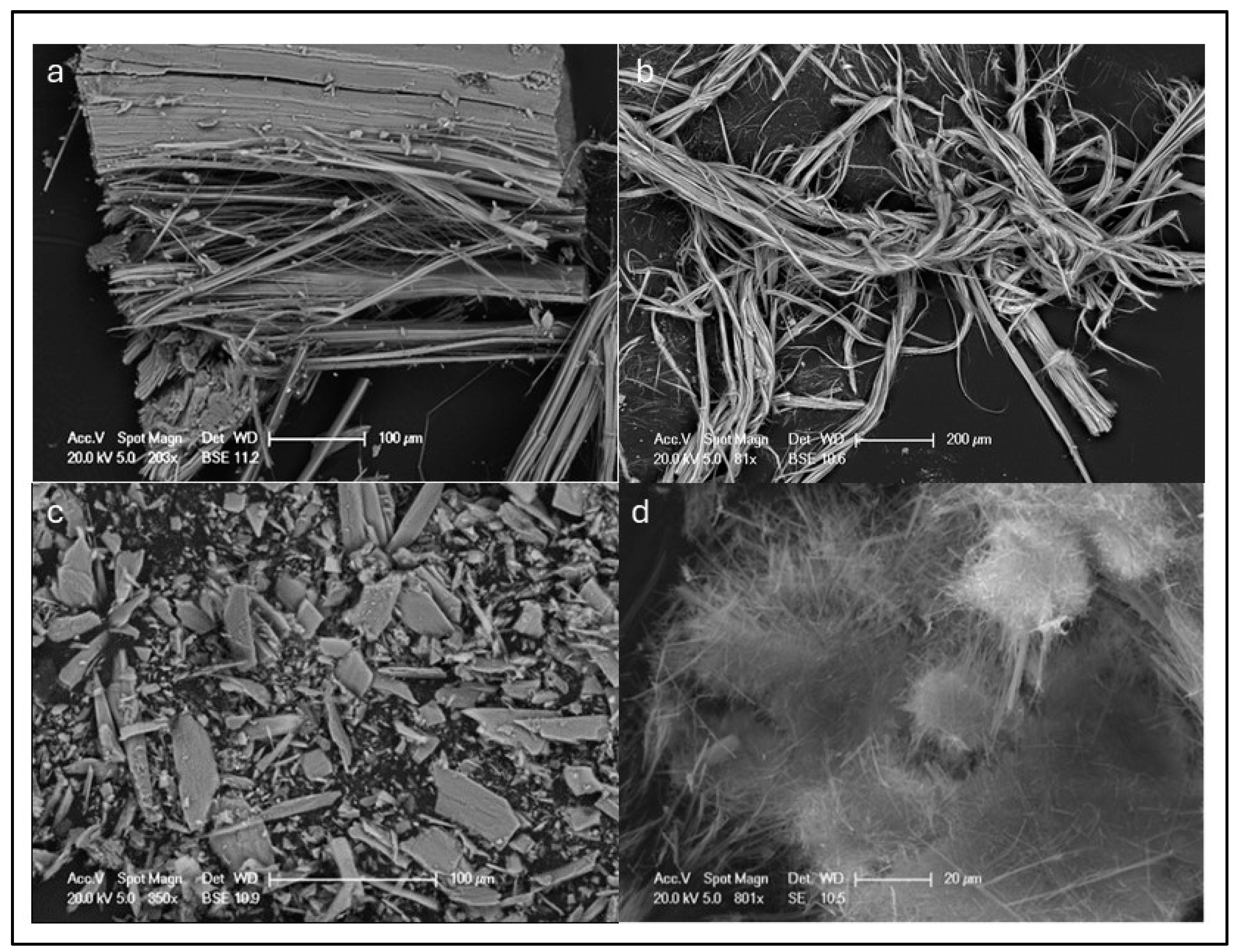
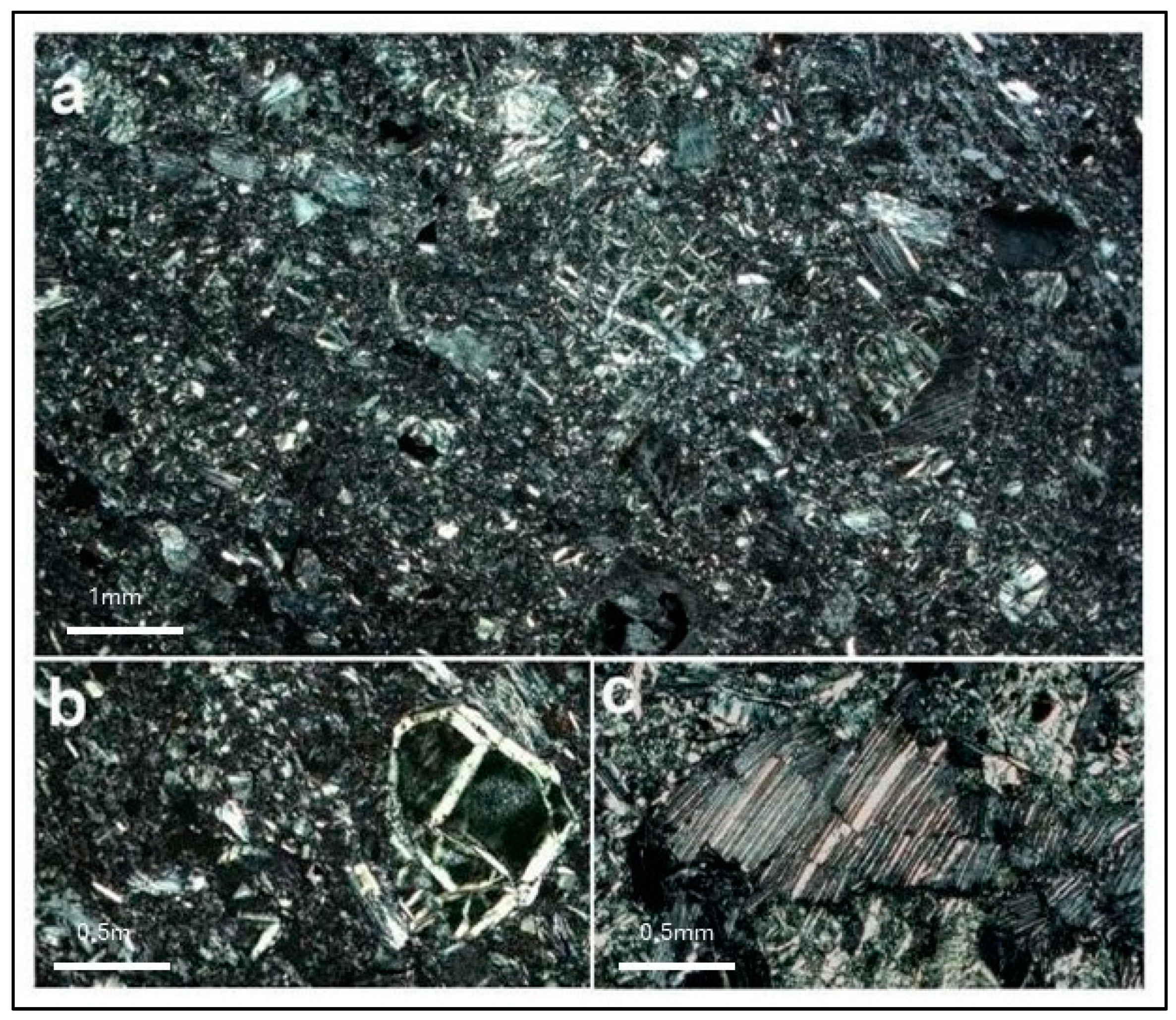
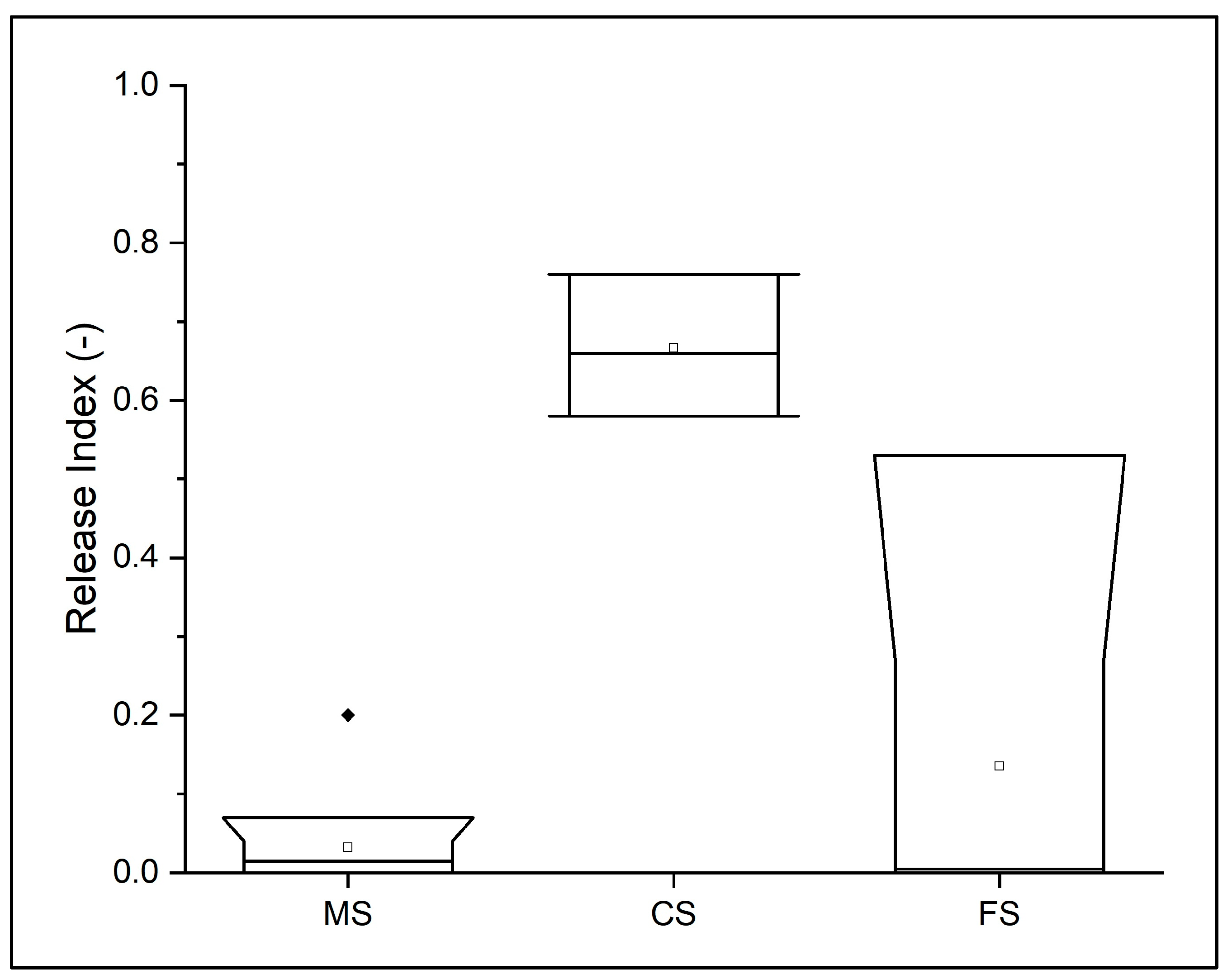
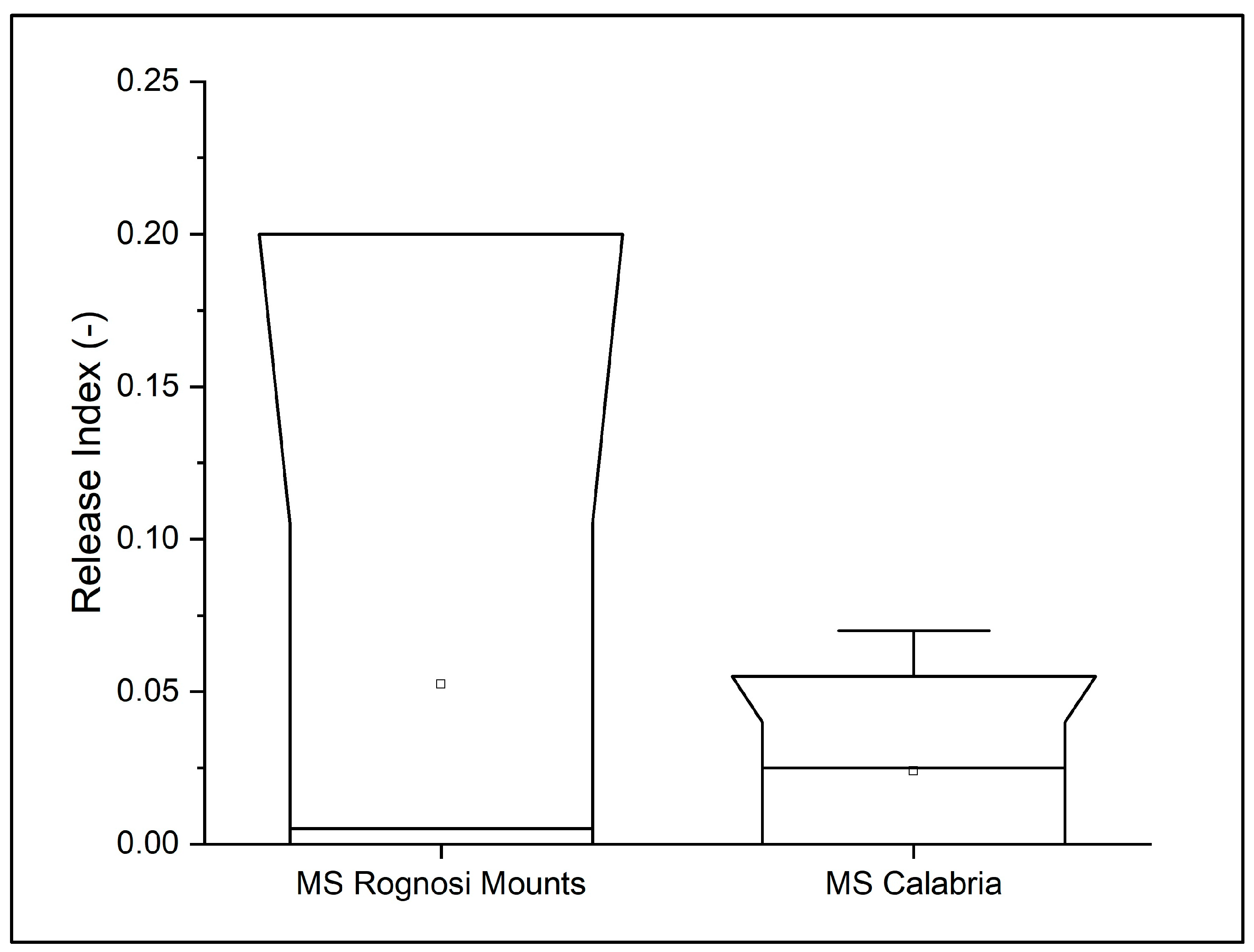
| # | Sample | Lithotype | Optical Microscopy | SEM/EDS | Wear Test and FTIR Analysis or SEM Counting |
|---|---|---|---|---|---|
| 1 | MtRog_01 | Massive serpentinite | X | X | X |
| 2 | MtRog_02 | Cataclasite | X | X | X |
| 3 | MtRog_03 | Massive serpentinite | X | X | X |
| 4 | MtRog_04 | Cataclasite | X | X | X |
| 5 | MtRog_05 | Serpentine veins | X | X | X |
| 6 | MtRog_06 | Serpentine veins | X | X | |
| 7 | MtRog_07 | Cataclasite | X | X | X |
| 8 | MtRog_08 | Serpentine veins | X | X | |
| 9 | MtRog_09 | Massive serpentinite | X | X | |
| 10 | MtRog_10 | Serpentine veins | X | X | |
| 11 | MtRog_11 | Massive serpentinite | X | X | |
| 12 | MtRog_12 | Massive serpentinite | X | X | |
| 13 | MtRog_13 | a = massive serpentinite (dunitic protolith); b = massive serpentinite; c = foliated serpentinite with pseudofibrous vein | X | X | |
| 14 | MtRog_14 | a = massive serpentinite; b = antigorite and tremolite veins; c = foliated serpentinite with sigmoidal chrysotile veinlets | X | X | |
| 15 | MtRog_15 | a = massive serpentinite; b = cataclasite; c = splintery antigorite vein | X | X | |
| 16 | 1S | Massive serpentinite | X | X | X |
| 17 | 2S | Massive serpentinite | X | X | X |
| 18 | 3S | Massive serpentinite | X | X | X |
| 19 | 4S | Massive serpentinite | X | X | X |
| 20 | 5S | Massive serpentinite | X | X | X |
| 21 | 6S | Massive serpentinite | X | X | X |
| 22 | 7S | Massive serpentinite | X | X | X |
| 23 | 8S | Massive serpentinite | X | X | X |
| 24 | 9S | Massive serpentinite | X | X | X |
| 25 | 10S | Massive serpentinite | X | X | X |
| Sample | Lithotype | Starting Weight (g) | Final Weight (g) | Powder Weight (g) | Density (g/cm3) | Bulk Density (g/cm3) | Relative Density (%) | Release Index (-) |
|---|---|---|---|---|---|---|---|---|
| MtRog_01 | MS | 500.62 | 478.07 | 22.55 | 2.70 | 2.65 | 98 | 0.01 |
| MtRog_02 | CS | 500.32 | 469.05 | 31.27 | 2.75 | 2.54 | 92 | 0.76 |
| MtRog_03 | MS | 500.20 | 462.20 | 38.00 | 2.66 | 2.56 | 96 | 0.20 |
| MtRog_04 | CS | 500.50 | 437.86 | 62.64 | 2.71 | 2.52 | 93 | 0.66 |
| MtRog_05 | FS | 500.15 | 410.70 | 89.45 | 2.73 | 2.54 | 93 | 0.53 |
| MtRog_06 | FS | 500.22 | 360.86 | 139.36 | 2.67 | 2.49 | 93 | 0.00 |
| MtRog_07 | CS | 500.48 | 432.62 | 67.86 | 2.71 | 2.59 | 95 | 0.58 |
| MtRog_08 | FS | 500.12 | 487.50 | 12.62 | 2.68 | 2.60 | 97 | 0.00 |
| MtRog_09 | MS | 500.34 | 475.26 | 25.08 | 2.72 | 2.61 | 96 | 0.00 |
| MtRog_10 | FS | 500.65 | 479.80 | 20.85 | 2.81 | 2.65 | 94 | 0.01 |
| MtRog_11 | MS | 500.23 | 481.10 | 19.13 | 2.70 | 2.60 | 96 | 0.00 |
| Sample | Lithotype | Starting Weight (g) | Final Weight (g) | Powder Weight (g) | Release Index (-) |
|---|---|---|---|---|---|
| 1S | MS | 502.20 | 394.13 | 108.07 | 0.03 |
| 2S | MS | 501.80 | 473.06 | 28.74 | 0.00 |
| 3S | MS | 503.40 | 449.00 | 54.40 | 0.04 |
| 4S | MS | 509.77 | 408.07 | 101.7 | 0.07 |
| 5S | MS | 503.74 | 487.11 | 16.63 | 0.00 |
| 6S | MS | 506.07 | 420.63 | 85.44 | 0.04 |
| 7S | MS | 510.80 | 421.15 | 89.65 | 0.01 |
| 8S | MS | 505.37 | 483.54 | 21.83 | 0.00 |
| 9S | MS | 505.50 | 472.50 | 33.00 | 0.02 |
| 10S | MS | 502.40 | 480.04 | 22.36 | 0.03 |
Disclaimer/Publisher’s Note: The statements, opinions and data contained in all publications are solely those of the individual author(s) and contributor(s) and not of MDPI and/or the editor(s). MDPI and/or the editor(s) disclaim responsibility for any injury to people or property resulting from any ideas, methods, instructions or products referred to in the content. |
© 2024 by the authors. Licensee MDPI, Basel, Switzerland. This article is an open access article distributed under the terms and conditions of the Creative Commons Attribution (CC BY) license (https://creativecommons.org/licenses/by/4.0/).
Share and Cite
Marzini, L.; Iannini, M.; Giorgetti, G.; Bonciani, F.; Conti, P.; Salvini, R.; Viti, C. Asbestos Hazard in Serpentinite Rocks: Influence of Mineralogical and Structural Characteristics on Fiber Potential Release. Geosciences 2024, 14, 210. https://doi.org/10.3390/geosciences14080210
Marzini L, Iannini M, Giorgetti G, Bonciani F, Conti P, Salvini R, Viti C. Asbestos Hazard in Serpentinite Rocks: Influence of Mineralogical and Structural Characteristics on Fiber Potential Release. Geosciences. 2024; 14(8):210. https://doi.org/10.3390/geosciences14080210
Chicago/Turabian StyleMarzini, Lorenzo, Marco Iannini, Giovanna Giorgetti, Filippo Bonciani, Paolo Conti, Riccardo Salvini, and Cecilia Viti. 2024. "Asbestos Hazard in Serpentinite Rocks: Influence of Mineralogical and Structural Characteristics on Fiber Potential Release" Geosciences 14, no. 8: 210. https://doi.org/10.3390/geosciences14080210







